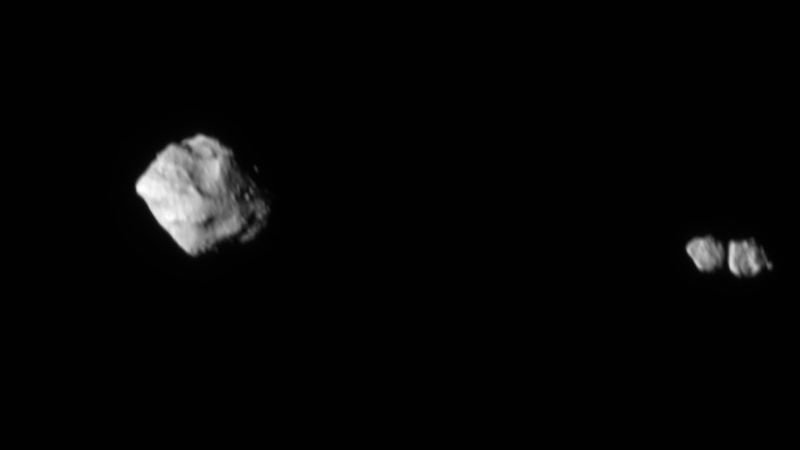NASA/Goddard/SwRI/Johns Hopkins APL
The Lucy mission captured stunning additional imagery, revealing that the asteroid Dinkinesh (left) has a contact binary companion, signifying two space rocks touching one another.
Subscribe to CNN’s Wonder Theory science newsletter. Delve into the universe with news on remarkable discoveries, scientific advancements and more.
CNN
—
Dinkinesh, a small asteroid visited by NASA’s Lucy mission last week, continues to astound. Lucy swung by the space rock located in the main asteroid belt between Mars and Jupiter on November 1 as part of a spacecraft equipment test before moving on to the primary mission goal of surveying Jupiter’s Trojan asteroids. The flyby of Dinkinesh, meaning “marvelous” in the Amharic language of Ethiopia, was not even added to Lucy’s itinerary until January.
However, the initial images captured by Lucy’s instruments revealed more than expected about the shadowy asteroid. The images initially suggested that Dinkinesh was part of a binary pair, with a smaller asteroid orbiting it.
NASA/Goddard/SwRI/Johns Hopkins APL/NOIRLab
The first image taken during the spacecraft’s closest approach revealed the companion, but not that it was a contact binary.
Additional images taken by the spacecraft after the closest approach have now revealed that the smaller asteroid is actually a contact binary — two smaller space rocks that touch each other.
Lucy came within 265 miles of the asteroid’s surface during its closest approach when the initial images were taken. The second set of images revealing the contact binary, shared by NASA on Tuesday, were taken six minutes later from 1,010 miles away.
“Contact binaries seem to be fairly common in the solar system,” said John Spencer, Lucy deputy project scientist at the Southwest Research Institute, in a statement.
“We haven’t seen many up-close, and we’ve never seen one orbiting another asteroid.
We’d been puzzling over odd variations in Dinkinesh’s brightness that we saw on approach, which gave us a hint that Dinkinesh might have a moon of some sort, but we never suspected anything so bizarre!”
The close approach was primarily designed to help the Lucy spacecraft test its terminal tracking system, which allows the spacecraft to locate the space rock autonomously and keep it within view while flying by at 10,000 miles per hour. The system surpassed expectations, allowing astronomers to make the discovery of Dinkinesh’s unexpected companion.
NASA/Goddard/SwRI
This graphic shows the Lucy spacecraft’s trajectory as it flew by Dinkinesh and when it captured the images revealing the asteroid’s surprising companion.
“It is puzzling, to say the least,” said Hal Levison, principal investigator for Lucy at the Southwest Research Institute, in a statement. “I would have never expected a system that looks like this. In particular, I don’t understand why the two components of the satellite have similar sizes. This is going to be fun for the scientific community to figure out.”
Data from the flyby is still being transmitted from the spacecraft to the mission team.
“It’s truly marvelous when nature surprises us with a new puzzle,” said Tom Statler, Lucy program scientist at NASA, in a statement. “Great science pushes us to ask questions that we never knew we needed to ask.”
Lucy’s next close encounter will be with another main belt asteroid called Donaldjohanson in 2025. And then, the spacecraft will set off to see the Trojans.
The Trojan asteroids, which borrow their name from Greek mythology, orbit the sun in two swarms — one ahead of Jupiter and another lagging behind. Too distant to be seen in detail with telescopes, the asteroids will receive a close-up when Lucy reaches them in 2027.
The mission derives its name from the Lucy fossil, discovered in Ethiopia in 1974. The NASA Lucy team aims for a comparable feat regarding the history of our solar system, mirroring how the Lucy fossil has aided in understanding human evolution. The asteroids are akin to fossils, representing the remaining material from the formation of giant planets in our solar system, including Jupiter, Saturn, Uranus, and Neptune.


